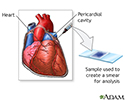Pericardial fluid Gram stain
Gram stain of pericardial fluid
Pericardial fluid Gram stain is a method of staining a sample of fluid taken from the pericardium. This is the sac surrounding the heart to diagnose a bacterial infection. The Gram stain method is one of the most commonly used techniques to rapidly identify the cause of bacterial infections.
How the Test is Performed
A sample of fluid will be taken from the pericardium. This is done through a procedure called pericardiocentesis. Before this is done, you may have a heart monitor to check for heart problems. Patches called electrodes are put on the chest, similar to during an electrocardiogram (ECG). You will have a chest x-ray or ultrasound before the test.
The skin of the chest is cleaned with antibacterial soap. The doctor then inserts a small needle into the chest between the ribs and into the pericardium. A small amount of fluid is taken out.
You may have an ECG and chest x-ray after the procedure. Sometimes, the pericardial fluid is taken during open heart surgery.
A drop of the pericardial fluid is spread in a very thin layer on a microscope slide. This is called a smear. A series of special stains are applied to the sample. This is called a Gram stain. A laboratory specialist looks at the stained slide under the microscope, checking for the presence of bacteria.
The color, size, and shape of the cells help identify the bacteria, if present.
How to Prepare for the Test
You will be asked not to eat or drink anything for several hours before the test. A chest x-ray or ultrasound may be done before the test to identify the area of fluid collection.
How the Test will Feel
You will feel pressure and some pain as the needle is inserted into the chest and when the fluid is removed. Your health care provider will likely give you pain medicine so that the procedure is not too uncomfortable.
Why the Test is Performed
Your provider may order this test if you have signs of a heart infection (myocarditis) or a pericardial effusion (fluid buildup of the pericardium) with an unknown cause.
Normal Results
A normal result means no bacteria are seen in the stained fluid sample.
What Abnormal Results Mean
If bacteria are present, you may have an infection of the pericardium or heart. Blood tests and bacterial culture can help identify the specific organism causing the infection.
Risks
Complications are rare but may include:
- Heart or lung puncture
- Infection
References
Chernecky CC, Berger BJ. Pericardiocentesis - diagnostic. In: Chernecky CC, Berger BJ, eds. Laboratory Tests and Diagnostic Procedures. 6th ed. St Louis, MO: Elsevier Saunders; 2013:864-866.
LeWinter MM, Imazio M. Pericardial diseases. In: Zipes DP, Libby P, Bonow RO, Mann DL, Tomaselli GF, Braunwald E, eds. Braunwald's Heart Disease: A Textbook of Cardiovascular Medicine. 11th ed. Philadelphia, PA: Elsevier; 2019:chap 83.
Review Date: 12/24/2020
Reviewed By: Jatin M. Vyas, MD, PhD, Assistant Professor in Medicine, Harvard Medical School; Assistant in Medicine, Division of Infectious Disease, Department of Medicine, Massachusetts General Hospital, Boston, MA. Also reviewed by David Zieve, MD, MHA, Medical Director, Brenda Conaway, Editorial Director, and the A.D.A.M. Editorial team.









